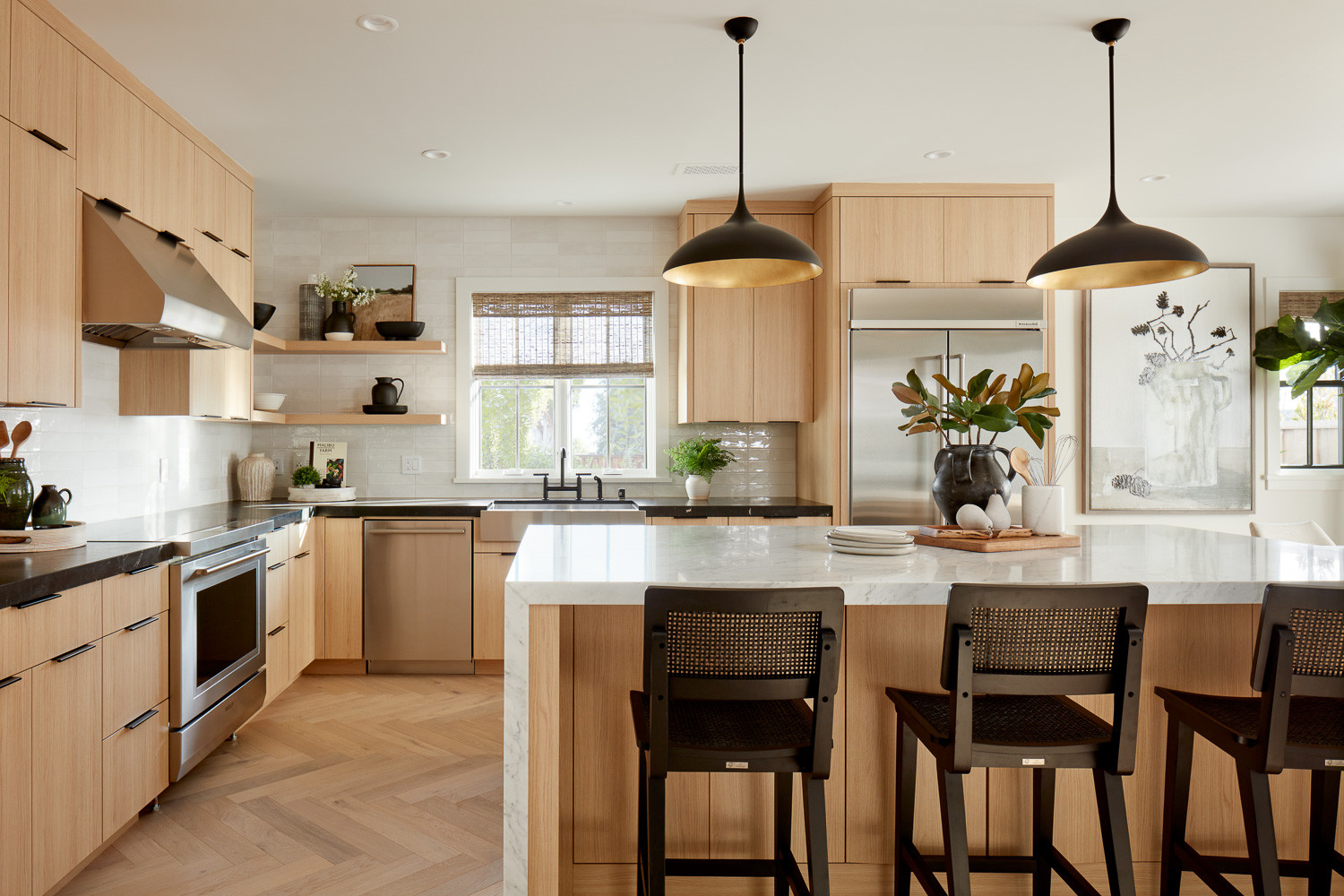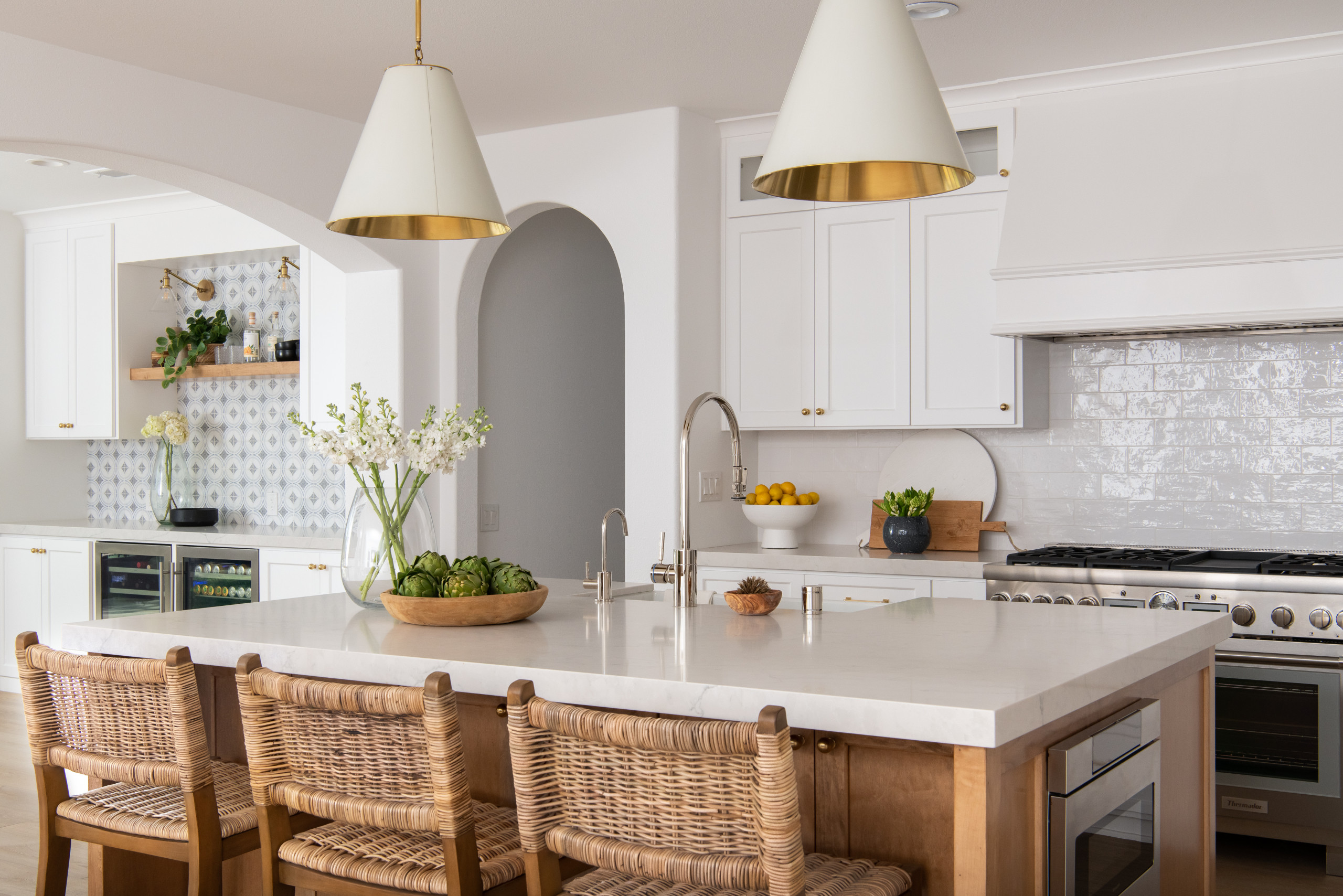How much does a kitchen remodel cost?
National AverageWhile the average cost to remodel a kitchen is $26,500, it can range significantly from or more depending on the scope of your project, the quality of materials, and cost of labor in your area. Use this calculator to estimate the cost of your kitchen remodel based on the information you input.
Estimate your project cost
Cost to Remodel a Kitchen
What factors affect the cost of remodeling a kitchen?
The most costly parts of a kitchen remodel are usually installing new cabinets, new countertops and new flooring. If you hire a professional to do the work, labor costs will also be a significant part of your total project cost. Here is a rundown of the variables that will impact your kitchen remodel costs
Kitchen Size:
Of course, the size of your kitchen will have a big impact on the cost of your project. The cost per square foot can vary widely depending on your materials, but the larger your kitchen is, the more material you’ll require, whether that’s drywall, flooring, cabinetry and countertop space.
Cabinetry:
Cabinets are one of the most expensive components of a kitchen remodel, but the cost of your cabinetry can vary significantly depending on the number of cabinets you need, and the material and style of cabinetry you choose. Along with those factors, you can decide to completely replace your cabinets, or for a more budget-friendly approach, reface them or repaint them. If you reface them, you’ll keep your existing box cabinets, but replace the doors to revamp the look of your kitchen.
If you’re replacing your cabinets, you’ll need to determine if you want more affordable stock cabinets, or if you’d prefer to customize them. Of course, you’ll have design flexibility if you customize your cabinets, but it can increase the budget significantly. As you’re evaluating the cost of cabinetry, don’t forget to factor in the cost of hardware.
Countertop Material:
Countertops will likely require a significant portion of your kitchen remodel budget, but the cost can depend on the material you choose and the square footage of your countertops. Whether you want a more budget-friendly option, such as laminate, or a higher-end material like marble, there’s a wide range of countertop materials at various price points to choose from. In addition to material costs, you’ll need to consider a number of factors, such as the countertop material’s durability, required maintenance, and installation costs.
Backsplash Material:
The cost of your backsplash can also vary significantly depending on the material you choose, the size of your backsplash, and whether you have it installed by a professional. While installing a backsplash is one of the easier DIY projects of a kitchen remodel, many homeowners hire a contractor to handle the installation. Ceramic tiles or classic subway tiles are popular, more affordable backsplash materials, whereas marble or mosaic backsplashes are on the pricier end of the spectrum.
Flooring Material:
Similar to countertops, there are myriad material options for kitchen flooring. The price will depend largely on the materials you choose, from affordable laminate to more expensive hardwood. Square footage will also impact the total cost.
Appliances:
In some cases, you may be able to save on appliance costs if your existing appliances are relatively new. However, if you’re in the market for new appliances, there’s a wide range of price points and costs will depend on the type and quality of the products. As you’re comparing costs for appliances, keep in mind that while energy-efficient appliances may cost more up front, they’ll provide savings in the form of lower energy bills. Now more than ever, there are a range of appliance colors and finishes available, so keep that in mind when you’re trying to create a cohesive look in your kitchen.
Lighting:
Whether you’re adding task lighting, ambient lighting, pendants or a chandelier to your kitchen, installing new lighting is a low-cost renovation that can make your kitchen feel much more inviting. While ambient lighting illuminates the whole room, pendants or a chandelier over your kitchen island or dining table can add a stylish touch and enhance the ambiance of a space. Task lighting refers to lighting that’s designated for a work space. For all of these lighting types, there are numerous options available. To save on energy bills, opt for energy-efficient lighting where possible.
Labor:
Labor costs for your kitchen remodel will depend on various factors, including the scope of your project, your geographic location, and the complexity of the work. Generally speaking, you can expect to allocate 20-25% of your budget on labor costs.
Location:
As with any home improvement project, local labor rates and fluctuating material prices can impact the cost to remodel your kitchen. Expect to pay more in metropolitan areas and places with higher costs of living.

Project Scope Considerations
While material and labor costs will make up the majority of your kitchen remodel expenses, there are some additional elements to factor in as you figure out a realistic budget for your project. Below are some critical project aspects to consider before starting your kitchen remodel.
Back to Calculator
Electrical Work: If you’re working with a general contractor, they’ll likely coordinate with an electrician during the process. Ideally, the electrician will advise from the beginning of the project to ensure the electrical requirements are clear. By doing so, your electrician can plan accordingly to make sure all functionality and safety needs are met. Not only that, but they can give you an estimate for the work that needs to be completed before you start the project.
Plumbing: If you’re not changing the layout of your kitchen, your plumbing costs will be relatively low because the water and gas lines can remain in place. In that case, you may only have straightforward plumbing needs, such as installing a new sink or faucet. However, if you’re planning a more significant remodel with layout changes, you may have to install new piping, move drain lines or relocate your water supply. For those types of projects, your plumbing costs will be significantly higher.
Gas Lines: You may need to factor in the cost of moving gas lines if you’re changing the location of your oven or cooktop, If you’re only shifting those appliances slightly, it’s possible that you can keep your gas lines in place because their tubing is flexible. However, if you’re completely relocating those appliances, you’ll want to get an estimate and plan in place for moving those gas before starting your remodel.
Painting: Painting your kitchen walls or ceiling is an easy way to update the look, and many homeowners choose to refresh the walls and ceiling as part of their kitchen remodel. While kitchens typically have less square footage to paint than other rooms because of cabinetry and appliances, the cost will vary based on the size of your kitchen, the complexity of the job and the quality of the paint.
To save on painting costs, some homeowners decide to paint their kitchens themselves. If you’re planning to go the DIY route, take the cost of paint and supplies into consideration.
Additional Scope Considerations
Back to Calculator
Design Fees: If you’re planning extensive changes as part of your kitchen remodel, you may want to hire a kitchen design professional to help. Even if your changes are less significant, an interior designer can give you guidance to realize your vision and ensure it comes together cohesively.
Demolition: Chances are, your contractor will build the costs for any demolition and prep work into your estimate, but if it’s not an explicit line item, confirm that their labor costs include the demolition and removal of old materials.
Repairs: Prior to kicking off your project, you may already be aware of kitchen repairs that need to be addressed. That said, it’s wise to include some padding in your budget, as you might discover unexpected issues such as leaks, cracks or water issues. Though these types of repairs will increase your project cost, fixing any issues will save you money down the line and prevent further (and more expensive) problems.
Permits: The cost of building permits can vary by your location, so consult with your general contractor to get a sense of the required permits and their relative costs. Oftentimes, your contractor will help you obtain the necessary permits for your kitchen remodel.

Remodel vs. Renovation
While kitchen “renovation” and “remodel” may sound similar, and are used interchangeably by some homeowners and professionals, there’s an important distinction between the two terms. A kitchen remodel is a large-scale project that transforms a space, and may include tearing down walls, replacing flooring, moving plumbing and rewiring.
A kitchen renovation, on the other hand, indicates that you’re restoring a space to look like new. A renovation often includes straightforward, cosmetic changes such as updating flooring, refacing cabinets and installing new sinks and faucets. Because the changes involved in a renovation are less significant than those in a remodel, renovation projects are generally less expensive.

Other Kitchen Remodel Cost Considerations
Beyond the main variables that factor into your kitchen remodel estimate, keep these additional cost considerations in mind:
Home Valuation: Kitchen remodels are known to provide a high return on investment, but the ROI can vary widely depending on several factors, including the scope of the project, the quality of the upgrades, and the local real estate market. Homeowners can typically expect anywhere from 55-78% for an ROI on a kitchen remodel. In general, smaller projects see higher returns than more extensive remodels.
Sustainability Savings: Sustainable kitchen elements may cost more up front, but they save you money over time. For example, if you invest in energy-efficient appliances and lighting, you can lower your utility bills.
Timeless Design: While you’ll want your updated kitchen to reflect your personal style, it’s wise to incorporate some classic elements and design features that are versatile and less likely to go out of style. You can add some flair when it comes to easily changeable aspects, such as paint and hardware, but it can save you money in the long run if you opt for timeless (and long-lasting) materials.

Looking for a Contractor?
Before starting a kitchen remodel, it’s wise to contact multiple general contractors for project quotes. By exploring your options, you’ll be able to compare estimates and make sure you’re getting a fair rate.
If you’re considering a mid- or large-scale kitchen remodel, perhaps you’d like to enlist the help of architects or designers. Search here to find top-rated architects if you’re planning to expand or reconfigure your space. For expertise on your kitchen design, find local designers here.
Note: Costs are estimated at the U.S. national level. Variations depend on factors such as the quality of materials, type of products installed and labor costs. The typical range is assumed to be between the 20th and 80th percentiles. The high-end and low-end costs are the maximum and minimum, respectively. Costs assume that the homeowner manages the project and hires subcontractors as needed. They include a subcontractor markup of 10% for materials and labor. Costs can be higher if a general contractor is managing the project. All numbers are rounded.
Source: 2019 Houzz Remodel Costs Database





